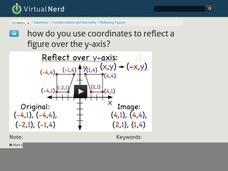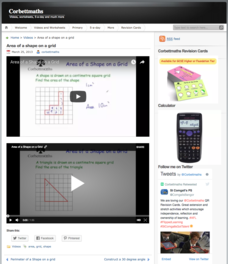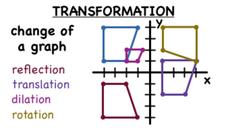Curated OER
How Do You Use Coordinates to Reflect a Figure Over the X-Axis?
Perform a reflection of a figure over the x-axis. This seems pretty straightforward. But also learn how to use the coordinates to reflect a figure.
Curated OER
How Do You Use Coordinates to Reflect a Figure Over the Y-Axis?
Perform a reflection of a figure over the y-axis. This seems pretty straightforward. But also learn how to use the coordinates to reflect a figure.
Mathed Up!
Mixed Transformations
Viewers learn how to identify and perform a variety of transformations with a video that provides seven items on transformations. Pupils demonstrate their understanding of dilations, reflections, rotations, and translations. The video...
Corbett Maths
Area of a Shape on a Grid
What does a grid have to do with area? Well, just about everything! Learners view composite shapes on a grid and watch as the video instructor finds their areas. The examples use shapes composed of rectangles and triangles. Scholars...
Corbett Maths
Finding the Mirror Line
Where does the reflection come from? The vivdeo starts with a quick review of the form of the equation of horizontal and vertical lines and diagonals passing through the origin. Using a pre-image and an image of a reflected figure, the...
Curated OER
What are Perpendicular Lines?
Perpendicular lines intersect to form right angles - four of them to be exact. Vertical angles, congruent angles, 90 degrees each, these are some of the special properties of perpendicular lines. Watch this video to find out a couple...
Curated OER
What is a Transformation?
A transformation is the process of changing the graph of a figure or a shape. The instructor introduces the four most common transformations: reflection, dilation, rotation, and translation. So watch as she draws the transformations on a...
Curated OER
How Do You Find a Value for x that Makes Two Lines Parallel?
So you have a transversal line intersecting two parallel lines and you are looking for a value that would make two corresponding angles congruent. You have all the information needed to write an equation to find the value. So write that...
Curated OER
What is a Translation?
A translation means moving a figure to another location by sliding it. The figure, called the image, maintains its size and shape. You can move the image horizontally, vertically, or a combination of both.
Curated OER
What Does Congruent Mean?
Two figures are congruent if they have the same size and shape. Line segments can also be congruent if they are of the same length. Vertical angles created by intersecting lines are always congruent. Polygons that have matching angles...
Curated OER
How Do You Find a Value for x that Makes Two Lines Parallel?
So you have a transversal line intersecting two parallel lines and you are looking for a value that would make two corresponding angles congruent. You have all the information needed to write an equation to find the value. So write that...
Curated OER
What is a Transformation?
A transformation is the process of changing the graph of a figure or a shape. The instructor introduces the four most common transformations: reflection, dilation, rotation, and translation. So watch as she draws the transformations on a...
Curated OER
What Does Congruent Mean?
Two figures are congruent if they have the same size and shape. Line segments can also be congruent if they are of the same length. Vertical angles created by intersecting lines are always congruent. Polygons that have matching angles...
Curated OER
What are Supplementary Angles?
What are supplementary angles? They are two angles that when added together make 180 degrees on a straight angle line. Hard to picture that? Then watch this video and see how the instructor illustrates this on a diagram.
Curated OER
How Do You Use Complementary Angles to Find a Missing Angle?
Are complementary angles nice to each other? That's not what complementary means in math. Complementary angles are two angles that add up to 90 degrees and form a right triangle. So if given one value in a problem about complementary...
Curated OER
What is a Translation?
A translation means moving a figure to another location by sliding it. The figure, called the image, maintains its size and shape. You can move the image horizontally, vertically, or a combination of both.
Curated OER
How Do You Find the Angles in a Triangle if You Have a Ratio of Their Measures?
Use the Triangle Sum Theorem to find the value of each of the inside angles of a triangle. This triangle problem has to do with the ratio of the angles to each other. Find the measure of each angle if the ratio is 1:3:8. Not sure how to...
Curated OER
How Do You Classify Triangles?
Triangles are classified by their angle measurement as well as by the length of their sides. Here are some names that identify the types of triangles: isosceles, equilateral, scalene, obtuse, and acute. Watch this video to learn about...
Curated OER
What is a Reflection?
There are many ways to transform geometric figures. This lesson will illustrate how to reflect figures over a line to get a mirror image of the figure. The teacher will draw three different reflections: one as reflected over the y-axis,...
Curated OER
What is a Line Segment?
Line, line segment, segment of a line, what does it all mean? Endpoints, midpoints, names of lines, names of segments. Watch this video and learn the definitions of these terms.
Curated OER
What are Acute, Obtuse, Right, and Straight Angles?
Angles are identified by the measurement of their angles. Well, that would make sense. The instructor illustrates four different angles and their names by identifying their degrees. Zero to less than 90 degrees is an acute angle, while...
Curated OER
What is an Angle?
An angle is formed when two rays share a common endpoint. Want to know more about angles? There are a lot of terms in this lesson. You might have to watch it two or even three times to make sure you understand all the terms. I recommend...
Curated OER
How Do You Translate a Polynomial Function Vertically?
Want to move a graphed function up or down? This is called a function translation. This video looks at translating a cubic function up three units. It considers the function in standard form, the graph of the function, and a table of...
Sophia Learning
Sophia: Intersecting Planes and the Coordinate Plane
In this video lesson, students use a coordinate plane to determine what happens when two more planes intersect. [2:26]
Other popular searches
- Coordinate Plane Geometry
- Plane Geometry Symmetry
- Point Line Plane Geometry
- Plane Geometry Shapes
- Plane Geometry Second Grade
- Plane Geometry and Theorems
- Plane Geometry Area
- Plane Geometry Symmetry 3d
- Plane Geometry Twelve
- Plane Geometry Middle Point
- Plane Geometry Symmetry 3
- Geometry Coordinate Graph























